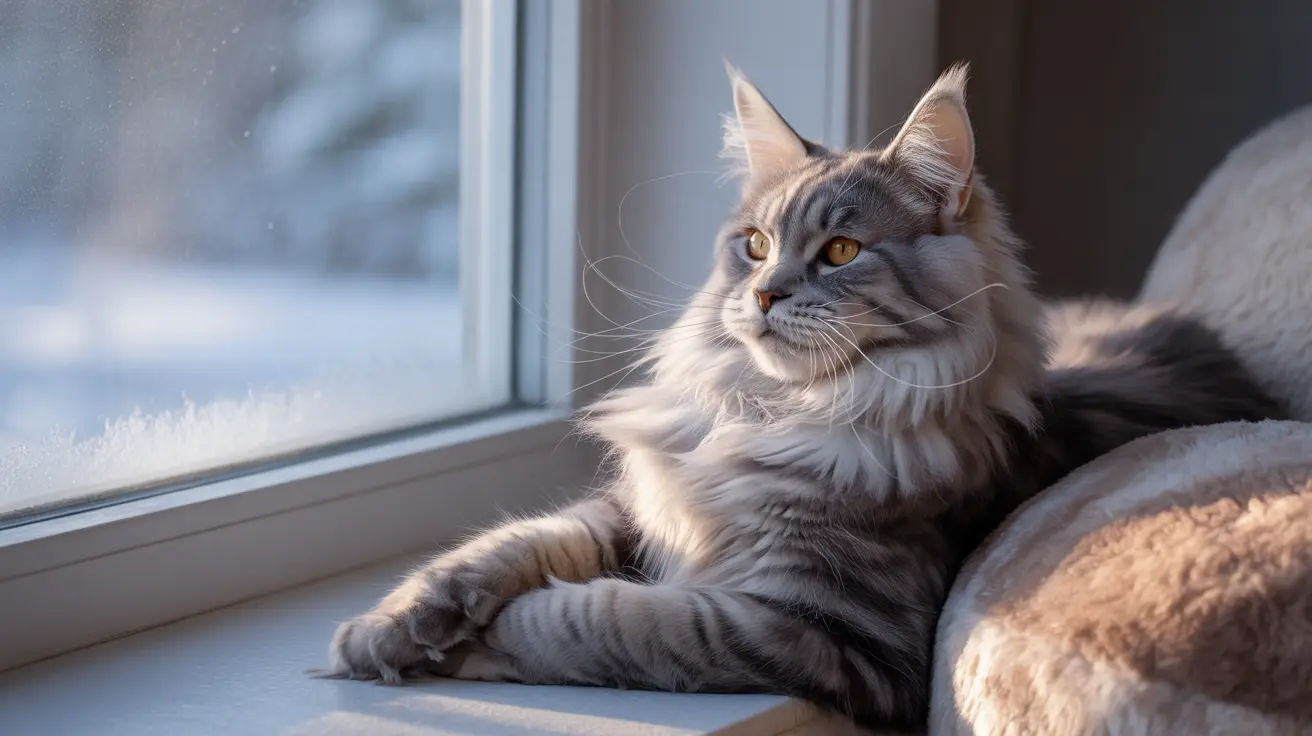Winter Fatigue in Cats Care: How to Help Your Feline Through Seasonal Depression
As the days grow shorter and winter settles in, many cat owners notice their feline companions becoming increasingly lethargic, sleeping more than usual, and showing less interest in their favorite activities. While cats naturally sleep 12-16 hours per day, during winter months, this can extend to an alarming 22 hours daily. This dramatic shift isn't just normal seasonal behavior—it's a sign that your cat may be experiencing winter fatigue and seasonal mood changes that require your attention and care.
Just as humans can develop Seasonal Affective Disorder (SAD), cats are also susceptible to mood and behavioral changes triggered by reduced daylight hours and environmental shifts. Although there's no scientific consensus that cats experience SAD in exactly the same way humans do, veterinarians and pet owners consistently observe symptoms that suggest felines suffer from seasonal mood disorders. Understanding how to recognize these changes and implement effective winter fatigue in cats care strategies can significantly improve your pet's physical and emotional well-being during the darker months.
The good news is that with proper care, environmental adjustments, and targeted activities, you can help your cat maintain their vitality and happiness throughout winter. This comprehensive guide will walk you through everything you need to know about identifying winter depression in cats and creating an enriching indoor environment that combats seasonal lethargy.
Recognizing Winter Fatigue and Depression in Cats
Identifying winter fatigue in cats requires careful observation of behavioral changes that typically emerge as daylight hours decrease in late autumn and early winter. Unlike temporary illness, seasonal mood changes in cats develop gradually and persist throughout the colder months, making early recognition crucial for effective intervention.
Physical and Behavioral Signs to Watch For
The most common indicators of winter fatigue include dramatically increased sleep patterns, with cats spending up to 22 hours daily resting compared to their typical 12-16 hours. This excessive sleeping often leads to muscle loss and excess fat accumulation, as reduced activity levels cause cats to lose their natural muscle tone while potentially gaining weight from decreased calorie burning.
Behavioral changes are equally telling. Cats experiencing winter depression typically show reduced interest in play, decreased social interaction with family members, and withdrawal from previously enjoyed activities. You may notice your cat becoming less responsive to toys, hiding more often, or showing reluctance to engage in their usual routines. Changes in eating habits are also common, with some cats developing increased appetite while others lose interest in food entirely.
Additional signs include increased vocalization, less frequent grooming leading to a duller coat, restlessness or agitation, and heightened sensitivity to routine changes. Some cats may become more clingy and attention-seeking, while others prefer isolation.
Distinguishing Seasonal Changes from Health Issues
It's essential to differentiate between winter fatigue and underlying health conditions that may present similar symptoms. Seasonal mood changes typically coincide with reduced daylight hours and develop gradually over weeks, while medical issues often appear more suddenly or show progressive worsening regardless of season.
If your cat displays extreme symptoms such as complete loss of appetite, excessive anxiety, dramatic weight changes, or obsessive overgrooming, consult your veterinarian immediately. These behaviors may indicate medical conditions requiring professional diagnosis and treatment rather than seasonal adjustment strategies.
Understanding the Causes of Winter Depression in Cats
The primary driver of winter fatigue in cats stems from their sensitivity to daylight changes and their natural crepuscular nature—being most active during dawn and dusk hours. As these transitional periods become shorter and less distinct during winter, cats lose important environmental cues that regulate their biological rhythms.
Hormonal and Neurological Factors
Reduced sunlight exposure significantly impacts cats' brain chemistry, particularly affecting levels of melatonin and serotonin—hormones crucial for regulating mood, sleep cycles, and overall well-being. Melatonin production increases in darkness, promoting sleepiness, while serotonin levels may decrease without adequate light exposure, potentially contributing to depressive symptoms.
Even spayed or neutered cats can experience seasonal hormonal shifts related to ancient breeding cycles, influencing their energy levels and behavioral patterns during winter months. These biological changes, combined with environmental factors, create the perfect conditions for seasonal mood disorders in felines.
Environmental and Social Influences
Sensory deprivation plays a significant role in winter depression. Indoor cats particularly suffer from monotonous environments lacking the varied stimuli they would naturally encounter outdoors. The absence of changing scents, sounds, temperatures, and visual stimulation during winter creates a dull, unstimulating atmosphere that contributes to lethargy and boredom.
Additionally, cats often mirror their owners' moods and energy levels. If human family members experience seasonal depression or alter their daily routines during winter, cats may respond with stress, confusion, or behavioral changes that compound their seasonal sensitivity.
Creating an Enriching Winter Environment
Combating winter fatigue requires transforming your home into a stimulating environment that compensates for the sensory limitations of the season. The goal is to recreate the variety and engagement your cat would naturally experience in a more dynamic outdoor environment.
Maximizing Natural Light Exposure
Light therapy represents one of the most effective interventions for winter depression in cats. Position your cat's favorite resting spots near windows or glass doors where they can access maximum natural sunlight during available daylight hours. Window perches create ideal basking areas that encourage cats to seek out and enjoy whatever natural light is available.
Consider investing in full-spectrum light boxes designed for pets, which can simulate natural sunlight and help regulate your cat's circadian rhythms. These devices are particularly beneficial for cats in homes with limited natural light or for those living in regions with severely shortened winter days.
Incorporating Sensory Stimulation
Sensory enrichment helps counteract the monotonous winter environment that contributes to feline lethargy. Introduce varying auditory stimuli through gentle bell chimes or wind chimes placed near windows where air movement will create natural sounds. These audio elements provide mental stimulation and can spark curiosity and alertness.
Visual stimulation through colorful herb bouquets or cat-safe plants adds natural elements to your cat's environment while providing scents that engage their powerful olfactory senses. Scented cushions with cat-safe herbs like catnip, valerian, or silver vine can create appealing rest areas that encourage exploration and play.
Indoor water fountains serve multiple purposes, providing fresh drinking water while creating soothing sounds and movement that many cats find fascinating. The combination of auditory, visual, and tactile stimulation from flowing water can significantly enhance environmental enrichment.
Providing Fresh Air Benefits
Contrary to common concerns, allowing fresh air into your home through opened windows or controlled drafts is not only safe but beneficial for cats during winter. Fresh air circulation prevents staleness and introduces subtle scent variations that stimulate your cat's senses without exposing them to dangerous cold temperatures.
Brief, supervised exposure to outdoor enclosures or protected balcony areas can provide valuable sensory experiences while maintaining safety. Even a few minutes of fresh air exposure can invigorate cats and provide mental stimulation that combats winter lethargy.
Implementing Interactive Play and Exercise Routines
Regular, structured play sessions are crucial for maintaining your cat's physical and mental health during winter months. The key is establishing consistent routines that replicate the hunting and exploration activities cats would naturally engage in during more active seasons.
Effective Toy Selection and Play Strategies
Interactive toys like feather wands, laser pointers, and motorized mice effectively reactivate lethargic cats by triggering their natural hunting instincts. These toys encourage running, jumping, and pouncing movements that help maintain muscle tone and cardiovascular health while providing mental stimulation.
Simple paper balls, cardboard boxes, and crinkly materials can provide hours of entertainment and encourage independent play between structured sessions. Rotating toys weekly prevents boredom and maintains novelty, ensuring continued interest and engagement.
Establishing Play Routines
Create consistent daily play sessions, ideally during dawn and dusk hours when cats are naturally most active. Start with 10-15 minute sessions twice daily, adjusting duration based on your cat's response and energy level. Gradually increase activity as your cat's fitness and interest improve.
Incorporate puzzle feeders and treat-dispensing toys to combine mental stimulation with physical activity. These tools encourage problem-solving while making meal times more engaging and extending eating duration, which helps combat boredom and overeating.
Nutritional Support and Health Monitoring
Winter care for cats should include nutritional adjustments that support their changing metabolic needs and activity levels during colder months. Proper nutrition plays a crucial role in maintaining energy levels and supporting overall well-being when environmental factors contribute to lethargy.
Dietary Considerations
Monitor your cat's weight carefully during winter, as reduced activity combined with potential comfort eating can lead to unhealthy weight gain. Gradually adjust portion sizes if needed, and consider switching to a weight management formula if your veterinarian recommends it.
Some cats may benefit from supplements that support mood and energy levels, but these should only be introduced under veterinary guidance. Omega-3 fatty acids, in particular, may help support brain health and mood regulation during challenging seasonal periods.
When to Seek Veterinary Care
While seasonal mood changes are common, certain symptoms warrant professional evaluation. Consult your veterinarian if your cat displays extreme anxiety, drastic appetite changes lasting more than a few days, obsessive overgrooming, complete withdrawal from social interaction, or any behavior that seems concerning or unusual for your pet.
Regular wellness checkups during winter months help distinguish between seasonal behavioral changes and underlying health issues that may be contributing to lethargy or depression.
Frequently Asked Questions
- How long does winter depression typically last in cats? Winter depression in cats usually begins in late autumn as daylight hours decrease and continues throughout winter months, typically subsiding as spring approaches and natural light increases. Most cats show improvement within 2-3 weeks of implementing environmental enrichment and increased activity routines.
- Can indoor cats experience seasonal depression even if they don't go outside? Yes, indoor cats are actually more susceptible to seasonal mood changes because they experience greater sensory deprivation during winter months. Without access to natural environmental variations, indoor cats rely heavily on their owners to provide stimulation and enrichment that combats seasonal lethargy.
- Is it normal for cats to sleep 22 hours a day in winter? While cats naturally sleep 12-16 hours daily, sleeping 22 hours represents excessive winter lethargy that can lead to muscle loss and health issues. This level of inactivity indicates your cat needs additional stimulation, play, and environmental enrichment to maintain healthy activity levels.
- Are certain cat breeds more susceptible to winter depression? While all cats can experience seasonal mood changes, those with higher energy levels and more social personalities may show more noticeable symptoms when their stimulation needs aren't met during winter months. However, any cat can benefit from proactive winter care strategies.
- Can light therapy really help cats with seasonal depression? Yes, full-spectrum light therapy can be beneficial for cats experiencing winter mood changes. These lights help regulate circadian rhythms and support healthy melatonin and serotonin levels. However, introduce light therapy gradually and consult your veterinarian for guidance on appropriate products and usage.
- How do I know if my cat's winter behavior changes require veterinary attention? Seek veterinary care if your cat shows extreme symptoms such as complete loss of appetite, excessive anxiety, dramatic weight changes, obsessive grooming, or behaviors that seem concerning beyond typical seasonal adjustments. Professional evaluation helps distinguish between seasonal changes and underlying health issues.
- Will my cat's winter depression affect their long-term health? With proper care and intervention, seasonal mood changes shouldn't cause long-term health issues. However, prolonged inactivity can lead to muscle loss, weight gain, and other health problems, making proactive winter care essential for maintaining your cat's overall well-being throughout the season.
Conclusion
Winter fatigue in cats care requires understanding, patience, and proactive intervention to ensure your feline companion maintains optimal health and happiness during the challenging winter months. By recognizing the signs of seasonal depression, creating an enriching indoor environment, and implementing consistent play and stimulation routines, you can significantly improve your cat's quality of life during the darker season.
Remember that seasonal mood changes in cats are natural responses to environmental shifts, and with proper care, most cats can successfully navigate winter months while maintaining their physical and emotional well-being. The key lies in providing adequate sensory stimulation, maintaining consistent routines, and monitoring your cat's behavior for any changes that might require veterinary attention. Through dedicated winter care efforts, you can help your cat not just survive but thrive throughout the season, emerging into spring healthy, happy, and ready to embrace the returning warmth and light.






